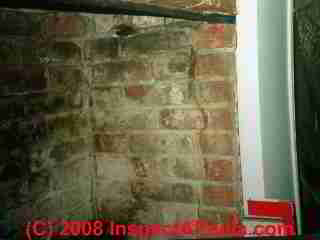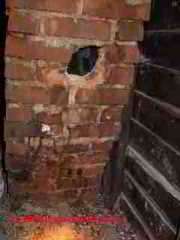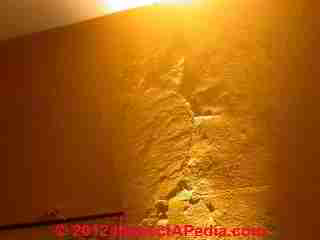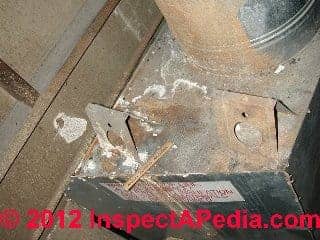 Chimney-Caused Stains on Building Interior Surfaces
Chimney-Caused Stains on Building Interior Surfaces
Chimney creosote, efflorescence, soot, water leak stain on ceilings, walls, floors
- POST a QUESTION or COMMENT about stains on building interiors that are traced to chimney problems
How to diagnose indoor stains at chimneys or caused by chimney problems.
What causes stains in, on or around chimneys and what do these stains mean? Unsafe chimney conditions may be indicated by leaks, stains, or crud seeping out of a chimney connection or a chimney crack. We point out that stains at chimneys are usually more than cosmetic and that they may indicate serious safety hazards as well as chimney functional problems.
This article series describes procedures for inspecting and repairing chimney flues - focused on stains that appear on the exterior surfaces or visible surfaces of chimney walls inside buildings.
InspectAPedia tolerates no conflicts of interest. We have no relationship with advertisers, products, or services discussed at this website.
- Daniel Friedman, Publisher/Editor/Author - See WHO ARE WE?
Significance of Stains on a Chimney Exterior Surface: Creosote, soot, water
 Water and Chimney Leaks Lead to Damage
Water and Chimney Leaks Lead to Damage
The pair of photos above and below teach several important chimney inspection lessons:
- It is important to notice stains on a chimney exterior surface:
stains from water, creosote, or soot leaking out of a chimney such as in this attic.
The stains tell us that water has been entering the flue, raising an alert for frost damage. This is not just a cosmetic concern: flue gases and sparks can enter the building. - Water leaking into a chimney
increases the chance of damage to the chimney flue or chimney structure. - Inspection distractions:
Don't let one observation at a chimney distract you or convince you that further up-close inspection is not needed.
When we crowded in around the corner to see the side of this chimney we found the gaping hole in the photo at right. - Looking into a chimney through any opening
that presents itself an tell us immediately whether or not the flue is lined and what is the thickness (and thus some information about safety) of the chimney walls.
Finding a chimney liner does not assure that the whole flue is lined and in good condition, but finding no chimney flue liner and a single wythe brick construction in any location tells us something important about the chimney safety.
These articles on chimneys and chimney safety provide detailed suggestions describing how to perform a thorough visual inspection of chimneys for safety and other defects. Chimney inspection methods and chimney repair methods are also discussed.
Water and Chimney Leaks Lead to Damage that may show up indoors on walls
Leaks originating at a chimney top, sides, even at ground level as well as chimney interior moisture sources (condensation) can all show up as stains on building interior walls at or near surfaces where the chimney passes through the building.
Indoor Stains & Wall Damage May Be Traced to Chimney Leaks

Our photos above and below show a rather obvious water leak from the inside of a chimney flue onto the wall and floor below. But other chimney leak clues that are less obvious may be present indoors too.
Illustrated in our photos below is the importance of looking closely at walls above a fireplace and where a chimney passes through a building.
Especially in poorly-lit rooms, the importance of proper use and aiming of a good flashlight become quite evident.
Our photographs show the discovery of water damage and efflorescence traced to a leaky chimney on a historic home in Newburgh, NY.
and this close-up below showing water damage along the passage of an interior chimney - from the room side (below):
Fireplace Stains May Indicate Chimney Leaks & Damage
At above left our fireplace photograph illustrates another spot to detect water leakage down the interior of a chimney structure or chimney flue.
Note the white efflorescence and stains on the back and sides of the fire box.
Without further investigation we can't be sure if the problem is a rain cap or a chimney cap seal or perhaps (less often) even a chimney to roof flashing problem.
The flue needs to be inspected for safety and the chimney leak found and repaired.
At above left the odd installation of chimney flue tiles run up through the middle of a fireplace ought to be a red flag to inspect closely for amateur and probably unsafe workmanship.
Watch out for
- improper sharing of a single flue between the fireplace and a basement heating appliance - unsafe conditions
- leaks at the chimney top - hidden chimney damage, possibly heater damage too
- improper and unsafe chimney construction
- more work on this home performed by the same do-it-yourself'ers
Aove we show white stains and rust atop a zero-clearance fireplace insert and more rust down the side of the metal flue itself.
You won't normally have access to inspect the interior of a finished fireplace insert.
But you should always be very alert for signs of leaks and rust damage to the unit, including inspecting inside the hearth as well as from the basement or crawl space below.
Rust damaged heating equipment may be unsafe.
 Stains and leak damage to a chimney may be visible in the attic
Stains and leak damage to a chimney may be visible in the attic
Brown or black oozing stains may appear on both masonry chimney and metal chimney exteriors, though if the metal chimney was properly assembled such leaks onto the metal chimney exterior surface are unlikely.
The brick chimney at left has both white and black stains as well as what looks like a vertical crack along its right side - this chimney maybe unsafe and needs prompt investigation.
The brick chimney with brown-black stains oozing from between the next chimney's mortar joints (photo at below left) tells us that water has been entering the chimney flue (missing rain cap or improper chimney top cap/crown seal or other chimney leaks).
These brown chimney stains may be still more significant: they may indicate that the chimney flue is unlined and possibly unsound and unsafe.
These black stains on a masonry or metal chimney are not mold. Mold prefers to grow on organic materials.
Stains, cracks, evidence of chimney leaks & damage may be visible in the basement

The stains down the side of the white-painted concrete block chimney shown at left were traced to foundation leaks - we found horizontal cracking in the concrete block foundation wall and more water stains in this same area.
The stains also led to observation of the cracking, damaged chimney base also visible in our photo at left.
Watch out: cracks in a masonry chimney mean movement, risk of hidden internal damage to the chimney flue, and potentially fatal flue gas leaks or to a building fire.
Brown or black oozing stains may appear near the bottom of a chimney below a thimble (where the flue vent connector inserts into the chimney) or around or below a chimney cleanout door (photo at left).
If you see marks such as those shown in our photo you will want to find the source of leaks into the chimney, such as a bad rain cap, chimney cap, roof flashing, or even ground water entering the chimney base - all problems that need be corrected.
Watch out: leaks into a chimney risk having damaged the chimney, flue vent connector, or heating appliance - making any of these dangerous, risking chimney damage, flue gas leaks, or a building fire.
...
Reader Comments, Questions & Answers About The Article Above
Below you will find questions and answers previously posted on this page at its page bottom reader comment box.
Reader Q&A - also see RECOMMENDED ARTICLES & FAQs
On 2021-11-27 by Inspectapedia Com Moderator (mod) - inspect water-damaged chimneys to find leak source & to check chimney safety
 @Dale,
@Dale,
That looks to me as if there is a water leak into the chimney. Simply cement its surface isn't fixing the leak - you need to find and fix the water source such as bad flashing or if that chimney is below grade, surface runoff, or even a bad chimney cap.
[Click to enlarge any image]
As we have no information about your building we have no clue about where the leaks are originating - so below we suggest inspection points that pretty much cover the topic from chimney cap, top, body, and into the ground below.
Start at the top at
CHIMNEY RAIN CAP / RAIN COVER INSPECTION
Then check
CHIMNEY FLASHING MISTAKES & LEAKS other leak points commonly found on masonry and some metal chimneys and flues
CHIMNEY STAINS & LEAKS
CHIMNEY DAMAGE by LEAKS & FROST
[see live links for these in the list of Recommended Articles at the end of this article.
Watch out: the hazard from water and frost damage to a chimney is more serious than stains or mold: if the actual flue is damaged the chimney may be unsafe risking fatal fire or carbon monoxide hazards. So you may want a certified chimney sweep to inspect the flue for safety.
On 2021-11-27 by Dale
I cemented over chimney getting wet spots
[Photo above]
On 2019-03-29 by (mod)
Melissa
Can you use the Add Image button to post a photo (one per comment) or two of the stain conditions on your chimney so that we have an idea what the problem is?
That would permit more-accurate advice.
If the metal flue is rusted badly it is unsafe and needs replacement.
But we want to know the cause of rust, such as leaks from outside, as that diagnosis can prevent further damage.
On 2019-03-29 by Melissa
How do you get water damage off the interior side of a black metal chimney stack
...
Continue reading at CHIMNEY STAINS & LEAKS or select a topic from the closely-related articles below, or see the complete ARTICLE INDEX.
Or see CHIMNEY STAINS, INDOORS FAQs - questions & answers about stains on chimneys indoors, posted originally at this article-end.
Or see these
Recommended Articles
- CHIMNEY INSPECTION DIAGNOSIS REPAIR - home
- CHIMNEY CAP & CROWN DEFINITIONS difference between a chimney rain cap and a chimney top seal - two different possible leak problems.
- CHIMNEY CLEANOUT DOOR
- CHIMNEY DAMAGE by LEAKS & FROST
- CHIMNEY FIRE ACTION / PREVENTION
- CHIMNEY FLASHING MISTAKES & LEAKS other leak points commonly found on masonry and some metal chimneys and flues
- CHIMNEY INSPECTION from GROUND
- CHIMNEY INSPECTION at ROOFTOP
- CHIMNEY RAIN CAP / RAIN COVER INSPECTION
- CHIMNEY SHOULDER LEAKS
- CHIMNEY STAINS, INDOORS
- CHIMNEY STAINS & LEAKS
- CHIMNEY WET TIME & CORROSION - effects of moisture on metal chimneys & flues
- CRACKED CHIMNEYS, MASONRY BLOCK
- CREOSOTE FIRE HAZARDS
- CREOSOTE HAZARDS
- CREOSOTE ODOR CURE / REMOVAL
- DRIPPING WATER SOUND SOURCES
- EFFLORESCENCE SALTS & WHITE DEPOSITS
- MASONRY CHIMNEY GUIDE - home
- METAL CHIMNEY & VENT INDOOR HAZARDS
Suggested citation for this web page
CHIMNEY STAINS, INDOORS at InspectApedia.com - online encyclopedia of building & environmental inspection, testing, diagnosis, repair, & problem prevention advice.
Or see this
INDEX to RELATED ARTICLES: ARTICLE INDEX to CHIMNEYS & FLUES
Or use the SEARCH BOX found below to Ask a Question or Search InspectApedia
Ask a Question or Search InspectApedia
Try the search box just below, or if you prefer, post a question or comment in the Comments box below and we will respond promptly.
Search the InspectApedia website
Note: appearance of your Comment below may be delayed: if your comment contains an image, photograph, web link, or text that looks to the software as if it might be a web link, your posting will appear after it has been approved by a moderator. Apologies for the delay.
Only one image can be added per comment but you can post as many comments, and therefore images, as you like.
You will not receive a notification when a response to your question has been posted.
Please bookmark this page to make it easy for you to check back for our response.
IF above you see "Comment Form is loading comments..." then COMMENT BOX - countable.ca / bawkbox.com IS NOT WORKING.
In any case you are welcome to send an email directly to us at InspectApedia.com at editor@inspectApedia.com
We'll reply to you directly. Please help us help you by noting, in your email, the URL of the InspectApedia page where you wanted to comment.
Citations & References
In addition to any citations in the article above, a full list is available on request.
- In addition to citations & references found in this article, see the research citations given at the end of the related articles found at our suggested
CONTINUE READING or RECOMMENDED ARTICLES.
- Carson, Dunlop & Associates Ltd., 120 Carlton Street Suite 407, Toronto ON M5A 4K2. Tel: (416) 964-9415 1-800-268-7070 Email: info@carsondunlop.com. Alan Carson is a past president of ASHI, the American Society of Home Inspectors.
Thanks to Alan Carson and Bob Dunlop, for permission for InspectAPedia to use text excerpts from The HOME REFERENCE BOOK - the Encyclopedia of Homes and to use illustrations from The ILLUSTRATED HOME .
Carson Dunlop Associates provides extensive home inspection education and report writing material. In gratitude we provide links to tsome Carson Dunlop Associates products and services.









